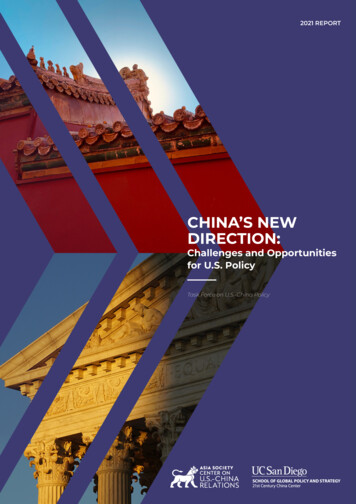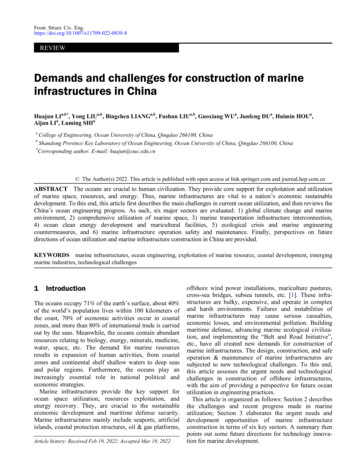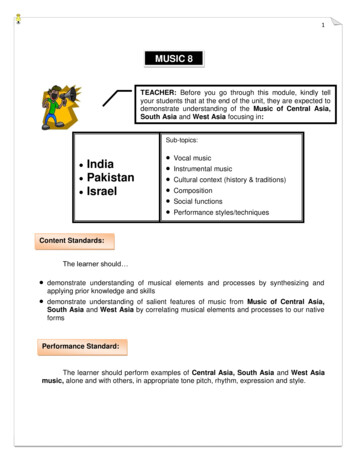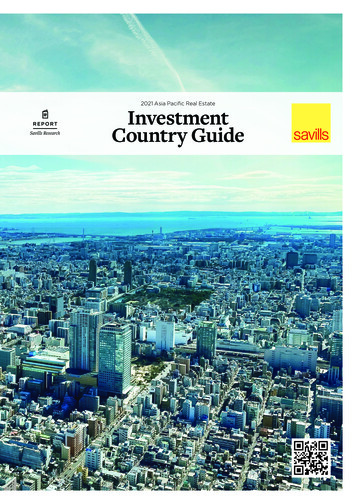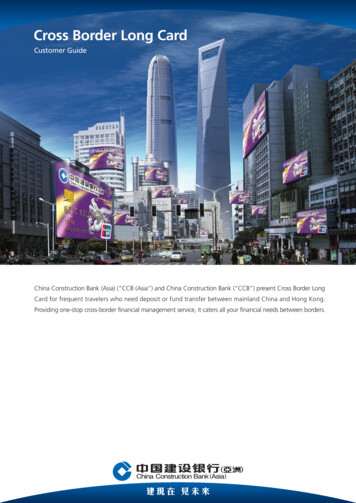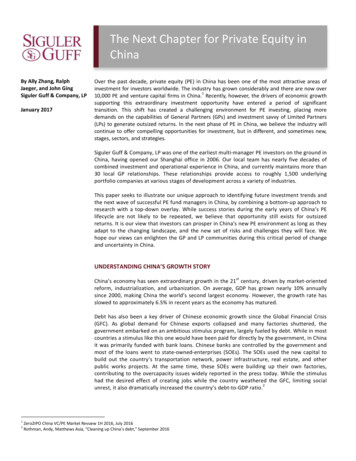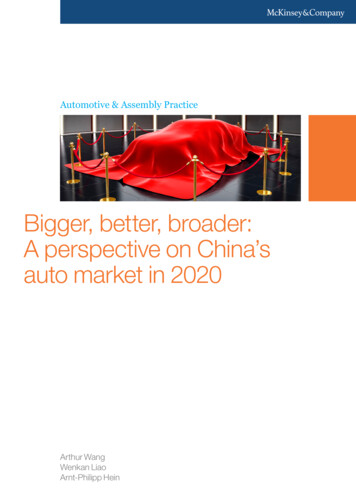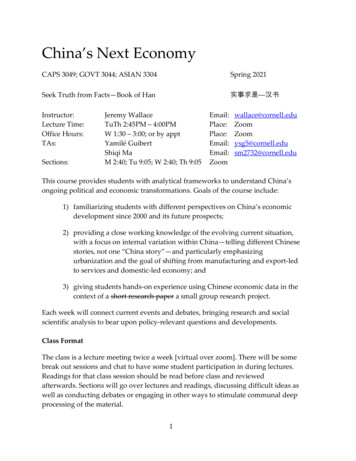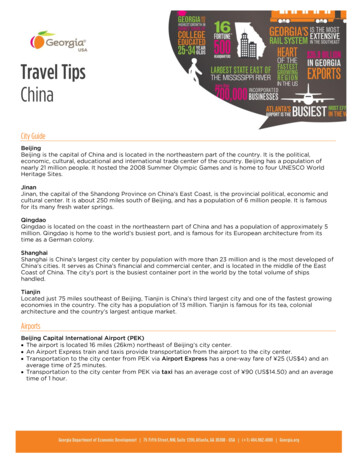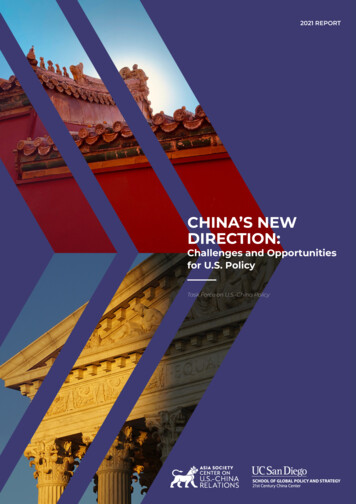
Transcription
12021 REPORTCHINA’S NEWDIRECTION:Challenges and Opportunitiesfor U.S. PolicyTask Force on U.S.-China Policy
iiCONTENTSCONTENTSFront Mattersiii About the Task Forceiv Task Force Participantsv Abbreviations1 Introduction2 Executive SummaryMemos3 Memo No. 1China’s Domestic PoliticsSusan Shirk, David Shambaugh and Jessica Chen Weiss6 Memo No. 2Chinese Society: Media, Education and Civil SocietyRobert Daly, Paul Gewirtz and Paul Haenle9 Memo No. 3Human Rights, Values and Ideology in ChinaWinston Lord, Andrew J. Nathan and Orville Schell12 Memo No. 4China’s EconomyArthur Kroeber, Charlene Barshefsky and Barry Naughton15 Memo No. 5China’s TechnologyBarry Naughton and Peter Cowhey18 Memo No. 6China’s Military ChallengeThomas Christensen, Zack Cooper, Karl Eikenberry, M. Taylor Fravel and Bonnie Glaser21 Memo No. 7Chinese DiplomacyM. Taylor Fravel, Bonnie Glaser and Evan Medeiros24 Memo No. 8U.S.-China Climate Cooperation, Coordination and CompetitionElizabeth Economy and Yasheng Huang
ABOUT THE TASK FORCEiiiABOUT THE TASK FORCEThe Task Force on U.S.-China Policy is a group of China specialists from around the U.S., convenedby Asia Society’s Center on U.S.-China Relations and the UC San Diego School of Global Policy andStrategy’s 21st Century China Center. It was established in Fall 2015, during an increasingly uncertaintime surrounding the U.S.-China relationship.The Task Force offered a set of recommendations to the incoming Trump Administration in its 2017report, “U.S. Policy Toward China: Recommendations for a New Administration.” A mid-term report in2019 followed, entitled “Course Correction: Toward an Effective and Sustainable China Policy.”In addition to the above, the Task Force formed “working groups” with other organizations to producethree topical reports. In 2018, it published “China’s Influence & American Interests: PromotingConstructive Vigilance.” that detailed the CCP’s efforts to influence American institutions in improperways. In 2020, it issued a report, “Dealing with the Dragon: China as a Transatlantic Challenge,” thatexamined changing European attitudes towards relations with China. A second report, “Meeting theChina Challenge: A New American Strategy for Technology Competition,” followed in November 2020and examined science and technology in the U.S.-China competition.This project was made possible by a grant from the Carnegie Corporation of New York, with additionalsupport from The Annenberg Foundation Trust at Sunnylands, and The Janet and Arthur RossFoundation.The Center on U.S.-China Relations was founded in 2006 and is based at Asia Society’s New Yorkheadquarters. The center undertakes projects and events which explore areas of common interestand divergent views between the two countries, focusing on policy, culture, business, media,economics, energy, and the environment.The mission of the 21st Century China Center is to produce and disseminate impactful evidencebased research about China, and to enhance U.S.-China relations by advancing scholarlycollaboration, convening policy discussions, and actively communicating with policy makers and thegeneral public in both countries. 2021 UC San Diego School of Global Policy and Strategy. All rights reserved.School of Global Policy and StrategyUniversity of California San Diego9500 Gilman Drive # 0519La Jolla, CA 92093-0519https://china.ucsd.edu/The UC San Diego School of Global Policy and Strategy’s 21st Century China Center take noinstitutional positions on matters of public policy and other issues addressed in the reports andpublications they sponsor. All statements of fact and expressions of opinion contained in this reportare the sole responsibility of its authors and may not reflect the views of the organization and itsboard, staff, and supporters.
ivTASK FORCE PARTICIPANTSTASK FORCE PARTICIPANTSCo-Chairs Orville Schell, Arthur Ross Director, Center on U.S.-China Relations, Asia Society Susan L. Shirk, Chair, 21st Century China Center, UC San Diego School of Global Policy and StrategyParticipants Charlene Barshefsky, Chair, Parkside Global Advisors Thomas J. Christensen, Director of the China and the World Program, Columbia University Zack Cooper, Research Fellow, American Enterprise Institute Robert Daly, Director of the Kissinger Institute on China and the United States, Woodrow WilsonCenter Elizabeth C. Economy, Senior Fellow, Hoover Institutions, Stanford University Karl Eikenberry, Former U.S. Ambassador and Retired Lieutenant General, U.S. Army M. Taylor Fravel, Arthur and Ruth Sloan Professor of Political Science and Director of the SecurityStudies Program, Massachusetts Institute of Technology Paul Gewirtz, Potter Stewart Professor of Constitutional Law and Director, Paul Tsai China Center,Yale Law School Bonnie Glaser, Director, Asia Program, German Marshall Fund of the United States Paul Haenle, Maurice R. Greenberg Director’s Chair, Carnegie–Tsinghua Center for Global Policy Yasheng Huang, Epoch Foundation Professor of International Management, MassachusettsInstitute of Technology Arthur R. Kroeber, Managing Director of GaveKal Dragonomics Winston Lord, Chairman Emeritus, International Rescue Committee; Former U.S. Ambassador toChina 1985-1989 Evan S. Medeiros, Penner Family Chair in Asia Studies at the School of Foreign Service,Georgetown University Andrew J. Nathan, Class of 1919 Professor of Political Science, Columbia University Barry Naughton, So Kwan Lok Chair of Chinese International Affairs, UC San Diego School ofGlobal Policy and Strategy Daniel H. Rosen, Founding Partner, Rhodium Group David Shambaugh, Professor and Director of the China Policy Program at the Elliott School ofInternational Affairs, George Washington University Jessica Chen Weiss, Associate Professor of Government, Cornell University
ABBREVIATIONSABBREVIATIONSAIArtificial IntelligenceBRIBelt and Road InitiativeCCGChinese Coast GuardCCPChinese Communist PartyCMMChinese Maritime MilitiaCONUSContinental United StatesCPTPPComprehensive and Progressive Agreement on Trans-Pacific PartnershipETSEmissions Trading SystemIADIntegrated Air DefensesNGONon-governmental organizationOECDOrganization for Economic Co-operation and DevelopmentPLAPeople’s Liberation ArmyPRCPeople’s Republic of ChinaTPPTrans-Pacific PartnershipWTOWorld Trade Organizationv
INTRODUCTIONINTRODUCTIONOrville Schell, Susan Shirk and Evan MedeirosThe year 2021 has proven to be a majorinflection point in U.S.-China relations, andespecially U.S. policy toward China. As China’sdomestic and foreign policies have becomemore autocratic at home and confrontationalabroad, America and other countries arerevising their strategies toward China.Externally, Xi Jinping is not only morecomfortable using power to advance China’sinterests, but also is expressing a vision thatis increasingly antagonistic to U.S. interests.Meanwhile, the Biden Administration hasembraced “strategic competition” as the framefor the relationship. Based on that concept, ithas sought to build a coherent approach tolong-term competition by enhancing America’svitality and its international partnerships.Many countries, especially liberal democraticstates, have hardened their postures againstChina. This has opened new space for closerU.S.-led international coordination on Chinapolicy, much to China’s dismay. While mostcountries, including the U.S., seek to avoid anew “Cold War,” they are struggling to find thebest ways to respond to myriad new challengesin an international order that is more fluid andunstable than before even while it remainsinterdependence as a key feature.In this world, the defining challenge facing theU.S., its allies and its partners is understandinghow China under Xi is evolving in the faceof changing domestic needs and externalpressures. Accordingly, a major policy risk is thatthe U.S. will misread or misinterpret what ishappening in China and will either overestimateor underestimate the threat China now poses.Such misjudgments could be disastrous andcould even lead to war.These concerns motivated this third report bythe Task Force on U.S.-China Policy. Formedin 2015, the Task Force was convened by AsiaSociety’s Center on U.S.-China Relations and theUniversity of California San Diego’s 21st CenturyChina Center. It brought together a group ofChina specialists with different backgroundsfrom across the United States. Earlier TaskForce reports in 2017 and 2019 reviewed U.S.China policy. In addition, it has issued threeworking group reports on China’s influenceoperation, science and technology in the U.S.China relations, and China as a trans-Atlantic1challenge. But the present moment may bethe most challenging time in decades, makingnow a critically important time for the U.S. tounderstand what is going on within China inorder to respond effectively. The old U.S.-Chinapolicy playbook urgently needs rewriting. To dothat, we need a clearer understanding of theforces behind the actions by Xi, the ChineseCommunist Party (CCP) and the Chinesegovernment.Why, for instance, did the Chinese leader notseek to ease tensions with the U.S. when theBiden Administration first took office? Why,instead, was there a ramping up of militarypressure on Taiwan, Japan and India, economicpressure on Australia, cyber-attacks on the U.S.and other Western powers, and intensifiedrepressive control over Xinjiang and HongKong that are bound to have internationalrepercussions? In Xi’s recent speech celebratingthe centennial of the Chinese Communist Party(CCP), he stressed the “historical inevitability” ofChina’s rise and warned that those who imaginethey can continue to bully, oppress or subjugateChina will “find their heads bashed bloodyagainst a great wall of steel forged by over 1.4billion Chinese people.” Such violent rhetoric,along with autocratic governance at home andbellicose “Wolf Warrior diplomacy” abroad hasplunged public opinion toward China in theU.S. and other liberal democratic countries tohistoric lows. It has also made engaging withChina more difficult than at any time since 1989.That said, any approach aimed at influencingChina’s behavior must recognize that China isnot monolithic. China has many social groups,with diverse interests and disparate politicalviews that, given the nature of China’s politicalsystem, are sometimes forced to fall silent.While Xi Jinping’s voice may be dominant, heis not the only voice or player in the Chinesesystem.The members of our Task Force have beenresearching Chinese economics, politics, society,military, and foreign policy, and interacting withChinese counterparts, for many years. PeterCowhey is not a formal member of the TaskForce, but as a technology policy expert, hehas led our effort on science and technologyin U.S.-China relations. In these pages, theauthors of each memo highlight some of themost significant trends underway within Chinaand suggest how they think this “inside-out”understanding of China might guide us towardmore effective U.S. foreign policy prescriptionsand proscriptions.11 This report is not a consensus document, but rather an effort to allow a variety of views represented by Task Force members to beexpressed. With this conceit in mind, we have asked different small groups to draft different sections: each “memo” reflects theirviews alone, and in no way is membership in the Task Force an endorsement of any section or the thrust of the report as a whole.
2EXECUTIVE SUMMARYEXECUTIVE SUMMARYThe report is divided into eight sections. Eachincludes a thumbnail analysis of the evolvingtrends inside China, and recommendationsfor how the Biden Administration mightincorporate such understandings into the nextphase of its China strategy. Below are some ofthe most significant insights identified by TaskForce members:1. POLITICSChina’s effective control of the pandemic andnationalistic rallying of popular opinion againstWestern powers’ blaming of China for itsoutbreak have strengthened Xi’s position in theParty and his popularity among the public. Wecan expect rules and norms to be finessed toextend Xi’s tenure for a third term at the 20thParty Congress next year. Xi’s dictatorial systemcreates pressures for officials to show loyalty anddistorts information feedback loops, two kindsof policymaking dynamics that lead to domesticand international overreaching.2. SOCIETYThe CCP has tightened supervision overuniversities, curtailed press freedom and placedcivil society groups under strict control. Still,there is great dynamism and diversity in China’seconomic and social life. That said, Chinesepeople rarely make explicit political demands,and their support for the Chinese CommunistParty appears to have grown in recent yearsalongside targeted retribution by the Partyagainst certain groups.3. HUMAN RIGHTSThe CCP has intensified its crackdown not juston opposition and dissent, but also on perceiveddisloyalty, disaffection, policy disagreementsand ideological nonconformity. Repressionand social control have reached their highestlevels in the post-Tiananmen period, especiallyin China’s peripheral regions such as Xinjiangand Tibet. In Hong Kong, Beijing has crushedautonomous political activity, academicand journalistic freedoms. All this reflects asurprising sense of siege on the part of theChinese government, despite the popularsupport it receives inside China.4. ECONOMYChina is using large-scale state interventionto increase national economic power andtechnological independence. The state ismobilizing significant financial support forfavored sectors and companies, distortingcapital allocation and corroding fair competitionand market-determined outcomes in Chinaand the rest of the world. Still, China is expectedto remain open to foreign investment andfinancial institutions so long as that serves thegovernment’s goals.5. TECHNOLOGYChina’s technology drive is massive in scale,led by the state but also enabled by anincreasingly state-influenced private sector.Chinese policymakers have doubled down ontheir commitment to become technologicallyindependent, especially in strategically essentialsectors like semiconductors. In fact, Beijing hasdone more to “decouple” its supply chain fromdependence on the U.S., than the other wayaround.6. MILITARYChina has developed a robust capability to fighteffectively within the first island chain that runsnorth to south from Japan and Taiwan to thePhilippines. These expanding capabilities areaimed at deterring and defeating U.S. militaryintervention in East Asia, especially in defense ofTaiwan.7. DIPLOMACYChina has abandoned its Deng Xiaoping-eralow-profile, risk-averse diplomacy. China’scurrent forceful foreign policy aims to protectits interests, ensure access to global markets,capital and technologies, and demandinternational respect for China’s achievements.Economic instruments are its preferred tool ofstatecraft, with active efforts directed towardshaping the global order regarding humanrights, internet governance, technologystandards and development finance. China’sleaders seek respect and even admiration fortheir Party-centered political system, thoughthey stop short of evangelizing or trying toexport a complete model of governance.8. CLIMATE CHANGEU.S.-China cooperation, coordination andhealthy competition will be essential if theworld is to achieve the 2015 Paris ClimateAgreement objectives, and if China is to achieveits 2060 carbon neutrality goals. China’s leadershave focused on developing clean technologiesand created financial incentives for climateaction within China. Yet, the government hasbeen reluctant to aggressively curtail coaluse at home and to reduce support for fossilfuel energy projects abroad if it means actingagainst the interests of state-owned enterprises.
MEMO NO. 1 CHINA’S DOMESTIC POLITICS3MEMO NO. 1CHINA’S DOMESTIC POLITICSSusan Shirk, David Shambaugh and Jessica Chen WeissThere are several defining features of China’spolitical system under Xi Jinping: The system has regressed from collectiveleadership with limited checks on powerholders to a highly centralized andpersonalistic dictatorship. Xi has defeated all his potential rivalsby means of a massive anti-corruptioncampaign, is popular with the public andnow appears set to rule China indefinitely. Xi has empowered the CCP’s organs tolead on policy making, and in doing so,degraded the authority of the State Councilin policy formulation and implementation. Xi has molded the CCP into an instrumentof his will that requires a high degree ofideological commitment from its members,and is a ubiquitous presence in Chinese life. Xi has uniquely expanded the use oftechnology for the purposes of surveillance,grid management, and social and politicalcontrol. Xi has become obsessed with politicalstability and threats to it; in response, hehas shifted the CCP’s national prioritiesfrom economic reform and development tonational and regime security regardless ofthe costs. Xi has carried out heavy-handed repressionof individuals, groups and media that areeven mildly critical of government policiesand performance.popular anger against the CCP and its “coreleader” Xi Jinping. But Xi’s quick and deftrecasting of the pandemic as a win for China’scentralized system, coupled with the Westernblame of China for mishandling the initialoutbreak and allowing the virus to spread sorapidly, has strengthened Xi’s support amongthe Chinese public.In effectively tackling COVID-19, Xi hasenhanced his iron grip on the military, the Party,the government apparatus, state enterprisesand, increasingly, on private enterprises. AsChina emerges from the COVID-19 pandemicand towards the epochal 20th Party Congressin Fall 2022, we assess that—barring healthproblems or “black swan” events—rules andnorms will be finessed or ignored so as tofacilitate Xi’s extended tenure for a third term.The CCP’s 100th anniversary featured variousgrand events with Xi Jinping at center stage,allowing him to project the image of an allpowerful ruler.Although some in the Party are unhappy withXi’s personalistic, centralized rule, which haseliminated power sharing, patronage andregular turnover of leadership from the system,his critics have been so completely silencedthat there is little sign of any overt oppositionto his continued rule. Still Xi and his securityapparatus surely want to avoid unpleasantsurprises in the lead-up to the Party Congress.For this reason, they are likely to continue theCOVID-19-related restrictions on foreign traveluntil the Congress.China’s one-party political system, longcomposed of multiple contending factions, isXi has defeated all his potential rivals . and now appears set to ruleChina indefinitely.1. The COVID-19 pandemic has strengthenedXi Jinping’s position within the ChineseCommunist Party and his popularity withthe public, making his mandate for a thirdterm at the Fall 2022 Party Congress a virtualcertainty. The COVID-19 crisis initially stirrednow dominated by one faction. Xi is advised by anarrow circle of trusted senior leaders, includingWang Qishan, Wang Huning, Li Zhanshu, ZhaoLeji, Ding Xuexiang, Cai Qi, Chen Xi, Liu Heand Huang Kunming. Party leadership bodiesas well as key provinces are packed with Xi’s
4MEMO NO. 1 CHINA’S DOMESTIC POLITICSpolitical allies, who exhibit no deviation from hisdictates. Xi is positioned to further consolidatehis power among the key CCP organs, in Beijingand the localities, during the upcoming PartyCongress.2. The overly centralized political systemdistorts incentives and impedes informationflows for policymaking, which leads to policyunpredictability and overreaching.Xi’s fixation on potential disloyalty among Partycadres and his fierce anti-corruption campaignhave created a tense political environment.Intimidated officials compete to display theirdeference (biaotai) to Xi rather than to provideobjective information about the consequencesof policies, creating a propaganda echochamber. Lower-level officials also rush tobandwagon on Xi’s wishes, carrying them outto an extreme that may exceed what Xi himselfwould desire. These dynamics may contributeto China’s domestic as well as internationalof COVID-19, despite initial missteps. Imagesof heroic CCP members on the frontlines ofthe pandemic have coincided with increasedapplications for Party membership. The CCP’scentenary celebration on July 1, 2021, andparticularly Xi’s Tiananmen speech, played tonational pride and the Party’s indispensable rolein what Xi calls “national rejuvenation.”Meanwhile, U.S. sanctions, technologyembargos, supply chain decoupling, delistingof Chinese companies on U.S. stock exchanges,restrictions on student visas, counterespionageinvestigations and anti-Asian violence haveincreased distrust and acrimony towards theU.S. among the Chinese public. The power ofU.S. democracy as an inspiration for Chineseliberals has also diminished.With the CCP selectively mobilizing Chinesenationalism against foreign “interference inChina’s internal affairs,” sensitive issues thatcould in the past be discussed, and evenThe days when the Party tolerated some forms of criticalexpression from abroad appear to be over.overreach, including China’s brutal crackdownon the Uyghurs in Xinjiang, its precipitousstripping of Hong Kong’s autonomy and itsconfrontational “Wolf Warrior” diplomacy.The internal dynamics in the CCP’s currentdictatorial system are a recipe for more policymissteps, which risk further damaging China’sinternational reputation and generating evenmore international pushback.One recent example of overreach is Beijing’sextreme resistance to a scientific investigationand disinformation about the origins ofCOVID-19. Xi may be wary of a resurgence ofthe kind of public anger that swept the countryafter the Party’s early 2020 COVID-19 cover-upand Xi’s inadequate attention at the beginningof the pandemic. Despite growing internationalpressure, Beijing is likely to continue tostonewall international efforts to determine theorigin of the COVID-19 pandemic, increasing thecosts for China’s international image.3. Nationalism is high and intensifying in theface of foreign criticisms.CCP propaganda touting the superiority of theChinese system resonates with many Chinese,who are proud of China’s achievements andresent foreign criticism. Surveys indicate thatpublic approval of the government has beenenhanced by its successful control of the spreadaccommodated, are now routinely rebuffed.The days when the Party tolerated some formsof critical expression from abroad appear to beover.The Winter Olympics in February 2022 offeranother occasion for the CCP to bolster itsbrand of patriotism at home. Any Westernboycotts, whether by corporate sponsors,governments or foreign tourists, may onlyfurther inflame China’s already superchargednationalism.RECOMMENDATIONS FOR U.S. POLICY INTHE POLITICAL REALM1. Revive civil society and cultural interactionswith China. International non-governmentaland civil society organizations have workedproductively and collaboratively in Chinafor more than 40 years. These people-topeople interactions help temper the dangersof adversarial competition by humanizingrelations, and state and local government tiescan also be valuable. However, Chinese-U.S. civilsociety ties have been greatly compromisedby Chinese restrictions on such interactions,especially due to the adoption of the NGO Lawin 2017, the ongoing crackdown on Hong Kongcivil society and media, and U.S. policy decisionsunder the Trump Administration.
MEMO NO. 1 CHINA’S DOMESTIC POLITICS5Despite this downturn, the U.S. government should support more societal, educational and culturalexchanges with China, and communicate a desire for closer people-to-people ties between theAmerican and Chinese publics. To this end, the U.S. government should work with Beijing to reopenthe Houston and Chengdu consulates and negotiate a balanced and reciprocal restoration ofjournalistic access and scholarly exchanges.2. Improve U.S. intelligence about China, particularly concerning the policy process and decisionmaking in Xi’s inner circle. The Director of National Intelligence and all U.S. intelligence agencieshave already identified China as a high priority, which should lead to better knowledge aboutmany facets of Chinese realities, including the inner workings of China’s political system. We alsorecommend improving China-related interactions between the U.S. policy community and nongovernmental scholars and experts, domestically and worldwide. The U.S. intelligence communityshould more clearly recognize and draw from the enormous reservoir of knowledge that existsoutside the government to better understand the dynamics driving China’s increasingly autocraticinternal and aggressive external behavior.3. Bolster American public diplomacy aimed at the Chinese public. American public diplomacy hastraditionally communicated goodwill and respect toward the Chinese public. While being forthrightin criticism of negative Chinese government behavior, U.S. public statements have taken care not tounnecessarily insult or inflame nationalistic sensitivities among Chinese citizens.It’s time to give renewed attention to American public diplomacy because growing resentment ofhostile U.S. rhetoric and actions could become a long-term liability. Washington should articulate apositive vision for a productive relationship that includes welcoming Chinese students, tourists andbusinesses that do not violate U.S. laws or compromise legitimate national security concerns. U.S.public diplomacy should also acknowledge what China has accomplished since 1978, especially ineconomic development and poverty reduction. Clumsily vilifying the Communist Party, or attemptingto create a wedge between it and the Chinese people, will be counterproductive at a time when thepublic increasingly seems to support the Party.A major U.S. policy speech, expressing both concern and affirmation, would help clarify Americanobjectives vis-a-vis China, including how the U.S. views China’s role in the world, what “competition”means to the U.S., and what type of regional and global order the American government supports.Such a high-level statement could become the anchor of a reenergized public diplomacy effort.
6MEMO NO. 2 CHINESE SOCIETY: MEDIA, EDUCATION AND CIVIL SOCIETYMEMO NO. 2CHINESE SOCIETY: MEDIA ,EDUCATION AND CIVIL SOCIETYRobert Daly, Paul Gewirtz and Paul HaenleCONTINUITY AND CHANGE IN CHINESESOCIETYChinese society is neither static norunidimensional. In the media, business,education and civil society domains, Chinesecitizens navigate both a top-down system ofgovernance and a bottom-up process of socialchange. Since 2012, even as the Party’s politicalcontrol tightened under Xi Jinping, Chinesecitizens have shown a high level of approval ofthe government’s focus on poverty alleviationand quality of life issues. But they have alsofound ways to advocate and organize for betterliving conditions, enhanced opportunity andincreased individual dignity. As individualexpectations rise, Chinese society continuesto evolve. The country’s dynamic businessenvironment, consumer goods marketplace,social relationships, cultural life and traveloptions were unimaginable to previousgenerations, even if they have been curtailedby COVID-19. The U.S. must understand thisongoing social change in order to deal withChina effectively.Xi’s declaration that “in political, military, civil,and academic affairs—north, south, east, westand center—the Party leads everything” echoesthe Maoist approach to social control, andreverses many of the practices and attitudesdeveloped over three decades of reform andopening. While the CCP under Xi asserts greaterinfluence over the media, education and civilsociety, the institutional rigidity of the Partyis confronted daily with the dynamism anddiversity of Chinese social life.With the outbreak of COVID-19, Chinesesocial media erupted with criticism of thegovernment’s initial response. Later in 2020,feminists publicly supported Zhou Xiaoxuan’sallegations of workplace sexual assault andfemale rock stars and stand-up comedianscalled for better treatment of women in theirlyrics and jokes. In today’s China, elderly citizensoppose raising the retirement age, deliveryworkers call for greater occupational safeguards,veterans protest denial of benefits, couplesmarry later and defer or opt out of parenthooddespite government calls for higher fertility,members of the LGBTQ community live openlyand are more accepted, high tech “gladiators”challenge inhumane work schedules, the youngpeople of the Lie Flat (tangping) movementopt out of the rat race altogether and a growingnumber of Chinese advocate for more onlineprivacy and less use of facial recognitiontechnology. In all of these ways, they are callingfor relief from the relentless pressures of work,family and political control of daily life. They areasking for a more humane society.Still, China is not ripe for revolution. Its peoplerarely make explicit political demands, and thedivide between China’s ordinary people and thegovernment should not be overstated. Xi hasbecome more autocratic, but Chinese in recentdecades have become more affluent, bettereducated and internationalized. Support forthe Party has ebbed and flowed, but appearsin surveys to remain substantial or appears tohave grown during the pandemic. The CCP’sresponsiveness to public concern over issueslike sexual harassment and consumer privacyhas allayed some opposition to the Party’sauthoritarian rule.1. The Communist Party is asserting greatercontrol over the media. Censorship has longbeen a key tool of the CCP’s societal controls,but the degree to which the Xi governmentnow controls China’s vast media landscape hasshocked both Chinese and foreign observers.China ranked 176th out of 180 countries onReporters Without Borders’ 2021 World PressFreedom Index. While China’s social mediaenvironment still allows for some discussion ofcontroversial t
by Asia Society's Center on U.S.-China Relations and the UC San Diego School of Global Policy and Strategy's 21st Century China Center. It was established in Fall 2015, during an increasingly uncertain time surrounding the U.S.-China relationship. The Task Force offered a set of recommendations to the incoming Trump Administration in its 2017
